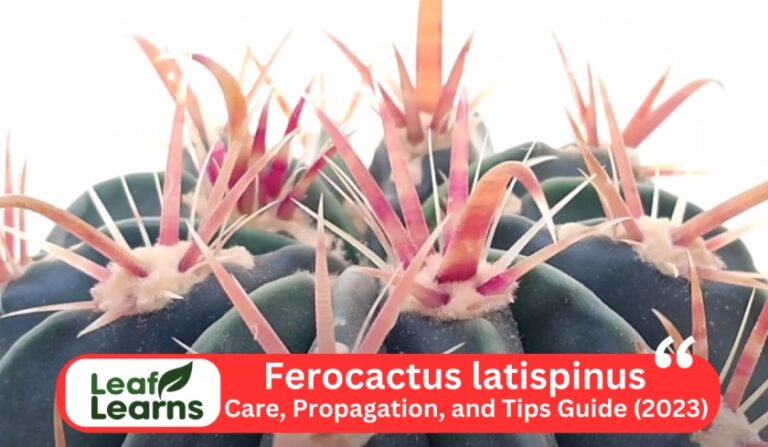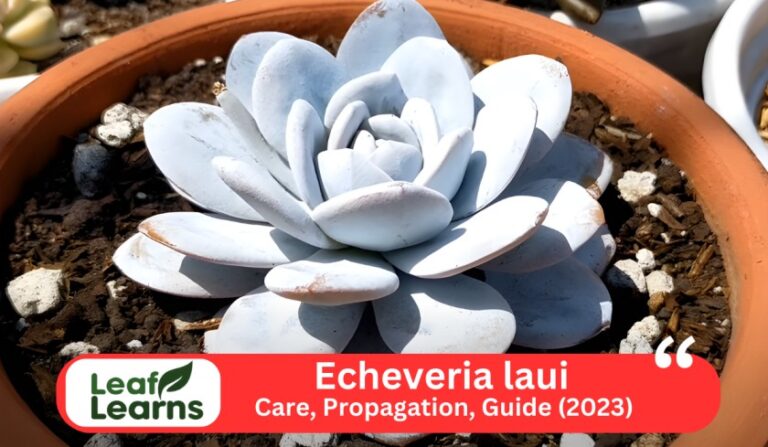How to Grow and Care for Fiddle Leaf Fig: Tips and Guide (2023)
The Ficus lyrata, commonly called as the Fiddle Leaf Fig or Ficus Lyrata. It belongs from the Moraceae family and originates in Western Africa, spanning from Cameroon to Sierra Leone. This beautiful indoor tree or shrub has a modest growth rate and can grow up to 10-15 feet tall. It needs bright, indirect sunshine for optimum growth.

Contents
- 1 Characteristics
- 2 Top Care Tips
- 3 How to Care for Fiddle Leaf Fig
- 4 Propagating Fiddle Leaf Fig
- 5 Pruning
- 6 Growth Rate and Size
- 7 Repotting Fiddle Leaf Fig
- 8 Flowering and Foliage
- 9 Common Pests
- 10 Plant Diseases
- 11 How to Get Fiddle Leaf-Fig to Bloom
- 12 Problems and Solutions
- 13 Toxicity of Fiddle Leaf Fig
- 14 Pets
- 15 Varieties/Types
- 16 Uses
- 17 Essential Fiddle-Leaf Fig Care Tips
- 18 Ficus lyrata Propagation, Pruning, and Pest Awareness
- 19 Conclusion
- 20 FAQs
Characteristics
It’s necessary to keep a well-draining, slightly acidic potting mix with a preference for moderate to high humidity levels ranging from 40–60% in order to care for this floral amazing. During the growth season, this plant benefits from monthly balanced fertilizer treatments and a temperature range of 65-75°F (18-24°C).
Although it may have difficulties like brown spots, falling leaves, root rot, or pests along the way, regular trimming to promote bigger growth and remove any dead or damaged leaves will ensure your Fiddle-Leaf Fig remains a beautiful centerpiece in your indoor garden.
| Feature | Description |
| Scientific Name | Ficus lyrata |
| Common Names | Fiddle Leaf Fig, Ficus Lyrata |
| Family | Moraceae |
| Native Region | Western Africa (Cameroon to Sierra Leone) |
| Plant Type | Indoor tree or shrub |
| Mature Height | Up to 10-15 feet (3-4.5 meters) |
| Growth Rate | Moderate |
| Light Requirements | Bright, indirect sunlight |
| Watering Frequency | Allow soil to dry slightly between waterings |
| Soil Type | Well-draining, slightly acidic potting mix |
| Humidity Needs | Moderate to high (40-60% humidity) |
| Temperature Range | 65-75°F (18-24°C) |
| Fertilization | Monthly during the growing season with balanced fertilizer |
| Pruning | To encourage bushier growth and remove dead or damaged leaves |
| Propagation Methods | Stem cuttings, air layering, or leaf cuttings |
| Common Issues | Brown spots, dropping leaves, root rot, pests |
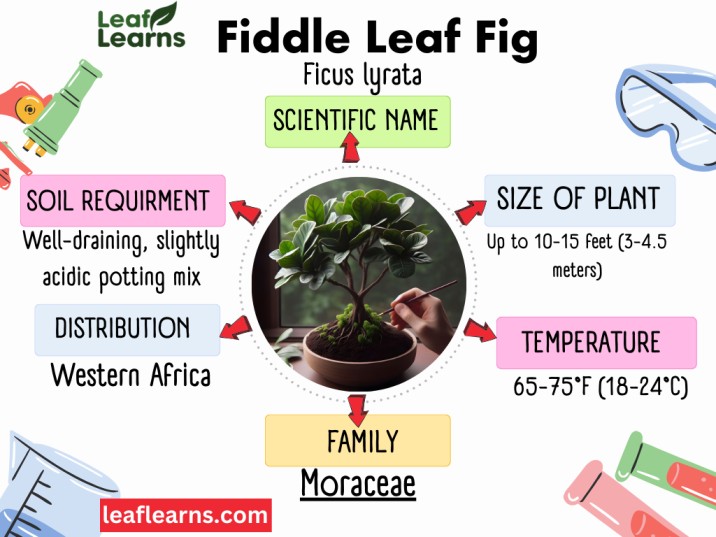
Top Care Tips
- Light Requirements: Your Fiddle-Leaf Fig needs bright, indirect sunshine for at least six hours each day in order to grow. Avoid the sun’s direct rays since they might burn the foliage.
- Before watering, let the top inch or two of the soil dry up. Root rot can result from overwatering, therefore it’s important to keep a regular but moderate watering plan.
- This plant need moderate to high levels of humidity, ideally between 40 and 60%. Use a humidity tray or frequently spritz the leaves to enhance humidity.
- Fertilisation: Feed your plant once a month with a balanced liquid fertilizer during the growing season (spring and summer). Fertilization should be reduced or stopped throughout the winter and autumn dormant seasons.
- To promote bushier growth and get rid of any brown or damaged leaves, prune your fiddle/Leaf fig. This promotes the general well-being and aesthetics of the plant.
How to Care for Fiddle Leaf Fig
Light Requirement
Despite not needing direct sunshine, Ficus lyrata require a lot of light. They want bright, comfortable lighting that allows you to read a book without straining your eyes.
Put your plant close to a window that has sheer drapes to block the sun. It won’t be content if you place it in a dim area.
Your Ficus lyrata will flourish and bloom nicely if you provide it with this soft, indirect light.
Water Requirements
The ideal amount of water for your fiddle plant is like Goldilocks finding the perfect bowl of porridge: it should be neither too much nor too little.
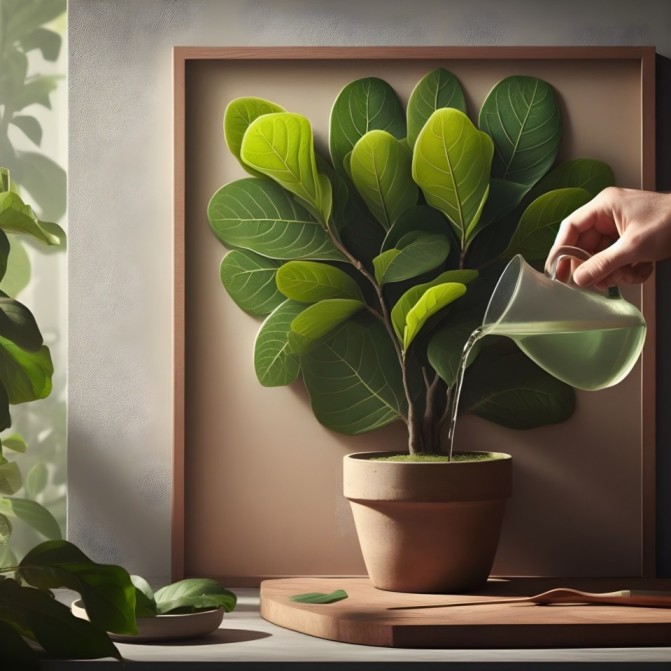
Before watering, allow the top inch of soil to dry. Give it a drink if it seems dry after sticking your finger in.
The issue is balance since too much water might smother the roots. Consider it as quenching rather than drowning your plant. Simple as pie, right?
Soil Requirement
Your fiddle-leaf fig requires the correct soil to grow well. Consider it as selecting comfortable footwear. The ideal soil for Ficus lyrata is well-draining and somewhat acidic.
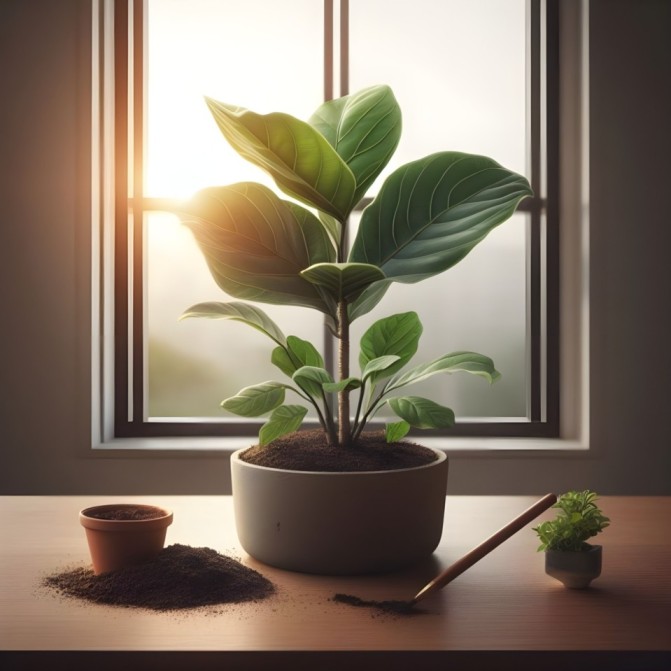
This implies that the soil should be capable of keeping some water, but not a lot. This unique soil mixture may be made at yourself or purchased at a garden supply store.
Temperature Requirement
Regarding temperature, fiddle leaf-figs are particular. They’re like Goldilocks: just the right temperature. Keep the temperature in your house between 18 and 65 degrees Fahrenheit.
They feel comfortable there. They can adapt to little changes but stay away from extremely hot or cold winds.
Your plant will flourish if you can find it a comfortable place to live. It could become irritable if it is excessively hot or chilly.
Humidity Requirement
Aim for around 40-60% humidity; you can achieve this by misting the leaves with water frequently or by placing a tray of water near the plant.
Ficus lyrata, like to be a little bit pampered in terms of humidity; imagine them as tropical guests.
They thrive in a home with moderate to high humidity levels, which means it should feel somewhat humid, like a spa day.
Fertilizer Requirement
Your Ficus lyrata will grow stronger and healthier if you fertilize it, which is similar to giving it a boost of plant food.
Once every month throughout the growth season, which is often in the spring and summer, feed your plant with liquid fertilizer. It receives the nutrition it requires to flourish as a result.
But keep in mind that your plant takes a rest in the autumn and winter, so don’t fertilize then. Therefore, feed it when it’s active, and you’ll get lush, green leaves in return.
Potting Requirement
It’s crucial to get the potting of your Ficus lyrata just perfect while taking care of it. To avoid overwatering, choose a pot with drainage holes at the bottom.
Use a potting mix that drains effectively to prevent soggy roots and to let extra water runoff.
By doing this, you can keep your fiddle leaf-fig healthy and prevent root rot.

Propagating Fiddle Leaf Fig
Stem Cuttings: Take a 6- to 12-inch-long clipping from the healthy stem’s tip. To avoid rot, remove any leaves from the bottom and let the cut end dry for a day or two. Place it in a soil mixture that drains properly, and until it roots, keep it continually wet.
Air Layering: This entails making a tiny incision on a sound branch, covering it with wet sphagnum moss, and wrapping it in plastic. After the branch below the root forms roots, you can clip it and put it in a different container.
Leaf Cuttings: Ficus lyrata may also be propagated from single leaves, but less frequently. Section a healthy leaf, then plant the pieces horizontally in potting soil. New plants will eventually appear at the base of each segment.
Water Propagation: Make sure a node (where a leaf grows) is immersed when you immerse the tip of a healthy stem in water. Once the roots have developed, transfer the plant to soil and change the water often.
How to Grow Ficus lyrata From Seed
It may be grown from seeds, which can be a pleasant experience. Obtain fresh Ficus lyrata seeds first. Put them in a little container with some potting soil that drains properly.
Always keep the soil wet, but not waterlogged. Put the pot in a cozy, well-lit area that receives some indirect sunshine. Be patient as germination could take some time.
You can move your seedling into a bigger container after it has become sturdy and tall. Ficus lyrata grow slowly, therefore to ensure its success, give your new plant lots of care and attention.
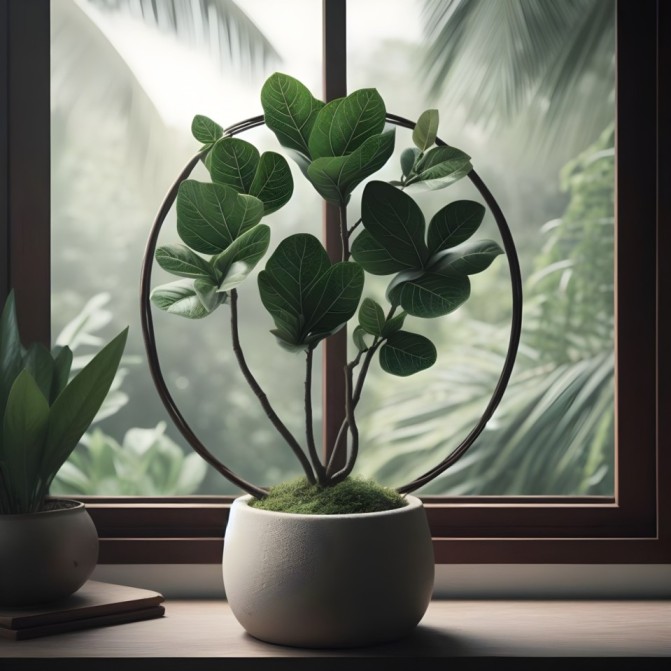
Pruning
Giving your Ficus lyrata a trim is like pruning it. You remove any branches or stems that are unhealthy, along with any dead or brown leaves.
This keeps your plant attractive and healthy. Additionally, it promotes new growth, which makes your fig tree bushier and more attractive.
Simply take a pair of fresh scissors or pruning shears and trim the areas that require it!
Growth Rate and Size
Ficus lyrata develop at a moderate rate, which means they neither grow quickly nor slowly. When completely developed, they may grow to a height of 10 to 15 feet (3 to 4.5 meters).
Imagine it as a medium-sized indoor tree or shrub that provides a dash of upscale greenery to your house without taking over your living room.
Repotting Fiddle Leaf Fig
- Moving your plant to a larger container is known as repotting. It’s time when the plant appears crowded or when the roots begin to overflow the present container. This is how:
- Select a pot that is somewhat bigger than the existing one.
- Remove the plant’s old pot with care.
- Insert it in the brand-new container with the new soil.
- Give it plenty of water.
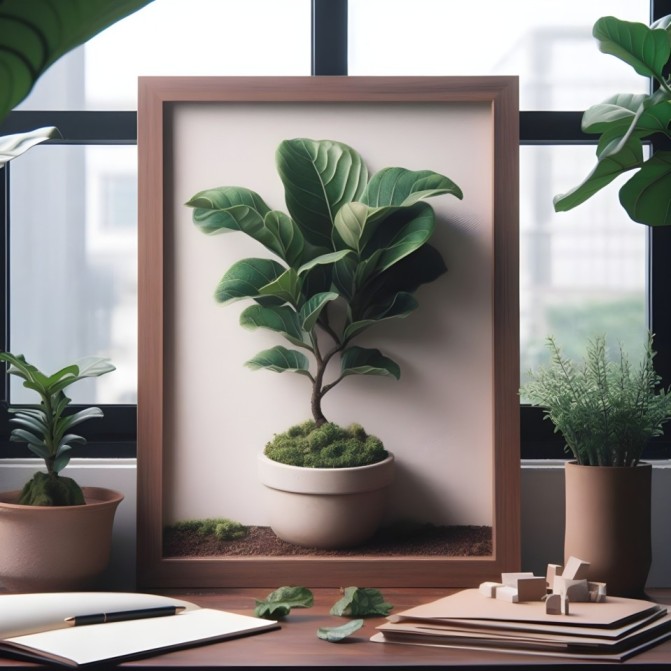
Flowering and Foliage
- Fiddle-Leaf Figs can blossom inside, but this seldom happens and rarely results in fruit. The blossoms are tiny and unnoticeable.
- Foliage: The plant’s big, glossy, violin-shaped leaves, which may reach a length of 15 inches, are its greatest selling point. These leaves’ vivid green color gives businesses and residences a stunning aesthetic appeal.
- Although the leaves is beautiful, you shouldn’t anticipate your plant to produce many or conspicuous blossoms. The highlight of the display is its vegetation.
Common Pests
Tiny pests like mealybugs, aphids, and spider mites are typical pests that might annoy your Ficus lyrata.
They harm the leaves by eating them and doing so often. Rinse the leaves after gently wiping them down with soapy water to get rid of them.
To maintain your Fiddle Leaf-Fig healthy and pest-free, keep a watch out for these creatures, particularly under the leaves, and take prompt action.

Plant Diseases
Common Problems: Ficus lyrata may have bugs, brown patches, and leaf loss.
Brown spots are dark blotches that develop on leaves and are frequently brought on by over watering or low humidity.
Dropping Leaves: If your plant is losing too many leaves, it may be stressed out from a change in the environment or from inappropriate maintenance.
Pests: Keep an eye out for insects that might harm your plant if they are not properly dealt with, such as mealybugs and spider mites.
These problems can be prevented and managed with routine care and observation.
How to Get Fiddle Leaf-Fig to Bloom
- Proper Light: Make sure your plant receives at least 6 hours each day of bright, indirect sunshine.
- Use a water-soluble, balanced fertilizer during the growing season (spring and summer).
- Maintain a consistent watering schedule and let the soil partially dry in between waterings.
- Humidity Boost: Mist the leaves or use a tray filled with water to maintain humidity levels between 40 and 60%.
- Trim slender branches to encourage bushier growth.
- Be patient since your fiddle leaf-fig’s flowers may not appear right away.

Problems and Solutions
Problem: Brown Spots on Leaves
Solution: Make careful to hydrate the soil properly, keeping it continuously wet but not waterlogged. To avoid fungus problems, avoid spraying water on leaves.
Problem: Leaves Turning Brown and Dropping
Solution: By spraying the plant or utilizing a humidity tray, you can maintain constant humidity. Verify the roots for rot and repot if necessary.
Problem: Pests (like spider mites or mealybugs)
Solution: Check your plant frequently for bugs. Use insecticidal soap or neem oil to treat.
Problem: Slow Growth
Solution: During the growth season, provide bright, indirect light and fertilise every month.
Problem: Leggy or Sparse Growth
Solution: Remove any dead or broken leaves and prune the plant to promote bushier growth.

Toxicity of Fiddle Leaf Fig
Pets: Dogs and cats can get poisoned after eating Ficus lyrata. Store them away from access.
Children: If youngsters consume the plant’s leaves or stems, it might potentially be dangerous. Keep children who might be intrigued out of it.
Symptoms: Children and cats that eat the substance may vomit, drool, or experience other digestive problems.
Safety: To avoid mishaps, keep your plant out of reach of children and dogs.
Pets
It’s crucial to be aware that fiddle-leaf figs can be poisonous to animals if they are ingested if you have cats or dogs and a fiddle leaf-fig. Your animal buddies might become ill if you give them the leaves.
Put the plant out of reach of your pets to keep them safe, or think about getting pet-friendly houseplants.
Varieties/Types
Regular Fiddle Leaf-Fig: The biggest, violin-shaped leaves distinguish this kind, which is the most prevalent. It’s what people often picture when they think of this plants.
Bambino Fiddle-Leaf Fig: The Bambino resembles the normal Ficus lyrata in size. Because it stays smaller, it’s ideal if you’re short on space.
Dwarf Fiddle-Leaf Fig: These plants are smaller than conventional ones, as the name implies. They work well in flats or smaller areas.
Variegated Fiddle-Leaf Fig: These plants feature lovely white or golden spot patterns on their leaves. They are renowned for their distinctive looks.
Fiddle-Leaf Fig Bonsai: These have undergone specific training to take on a bonsai-like form. They are ideal for tabletop decorations since they resemble little trees.
Uses
- Ficus lyrata are popular indoor ornamental plants that offer a sense of elegance and foliage to your house.
- Air purification: By removing contaminants and releasing oxygen, they contribute to bettering the quality of indoor air.
- Natural Room Divider: Their thick leaves may serve as a natural partition, dividing areas of a room.
- Having indoor plants, such as Ficus lyratas, might improve your mood and lower stress.
- When visitors come to your house, they are excellent conversation starters.
- Ficus lyratas are a popular choice for photography props due to their eye-catching leaves.
- They make meaningful and eye-catching presents for birthdays, housewarmings, and other events.
- Some people think that taking care of plants like fiddle leaf-figs helps encourage awareness and calm.
- Interior Design Element: They are frequently used by interior designers to improve the appearance of homes and workplaces.
Essential Fiddle-Leaf Fig Care Tips
Caring for a Ficus lyrata involves a delicate balance of attention to detail. Proper Ficus lyrata care begins with understanding its basic needs. When it comes to watering, these plants prefer a consistent moisture level. It’s crucial not to overwater or let the soil become waterlogged, as this can lead to root rot.
On the other hand, allowing the soil to dry out completely can stress the plant, causing brown spots and leaf drop. The ideal approach is to water when the top inch or so of the soil feels dry to the touch. As for light requirements, fiddle-leaf figs thrive in bright, indirect sunlight.
Placing them near an east-facing window is often ideal, but they can adapt to different lighting conditions. Maintaining adequate humidity by misting the leaves or using a humidity tray can help prevent leaf browning and curling.
When it comes to soil, a well-draining mix designed for tropical plants works best. Additionally, fertilize your plant every few weeks during the growing season to promote healthy growth.
Ficus lyrata Propagation, Pruning, and Pest Awareness
If you want to propagate your fiddle leaf-fig, you can do so through various methods, such as stem cuttings or air layering. Propagating from a single leaf is possible but less common. When pruning your Ficus lyrata, be cautious not to remove too much growth at once, as this can stunt its growth rate.
It’s essential to be aware of potential pests and diseases that can affect these plants, including spider mites and root rot. Regularly inspect your fiddle leaf-fig for any signs of trouble. Keep in mind that while fiddle-leaf figs are prized for their aesthetic appeal, they can be toxic to pets like cats and dogs, so be cautious if you have furry friends at home.
In terms of finding a Ficus lyrata, you can purchase them at various retailers, including local nurseries, IKEA, Costco, or online stores like Amazon. Whether you’re a seasoned plant enthusiast or a beginner, with proper care, your fiddle-leaf fig can become a beautiful and thriving addition to your indoor garden.
Conclusion
In conclusion, taking good care of your Ficus lyrata involves giving it the proper amount of light, water, humidity, and nutrients. Pruning promotes healthy growth.
These plants brighten rooms, clean the air, and improve spirits. Take measures though; keep in mind that they can hurt kids and pets.
FAQs
What are the light requirements for a Fiddle Leaf Fig?
It need bright, indirect sunlight for at least 6 hours a day.
How should you water a Fiddle Leaf Fig?
Allow the top inch or two of the soil to dry out before watering to avoid over watering.
What type of soil does a Fiddle Leaf Fig prefer?
It can prefer well-draining, slightly acidic soil.
What temperature range is ideal for a Fiddle Leaf Fig?
Keep your home between 65-75°F (18-24°C) for the best comfort of the plant.
How can you increase humidity for a Fiddle Leaf Fig?
To increase humidity, you can mist the leaves regularly or use a humidity tray.
When should you fertilize a Fiddle Leaf Fig?
Fertilize your Fiddle-Leaf Fig monthly during the growing season (spring and summer).
How can you propagate a Fiddle Leaf Fig?
You can propagate a Ficus lyrata through stem cuttings, air layering, leaf cuttings, or water propagation.


